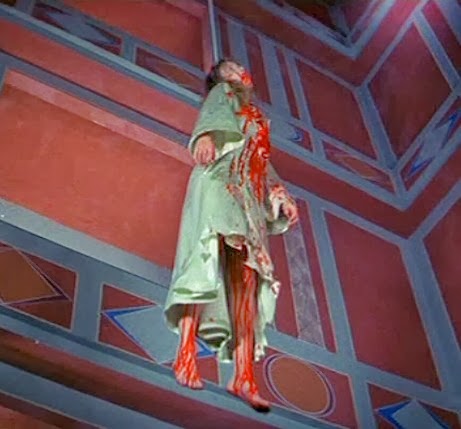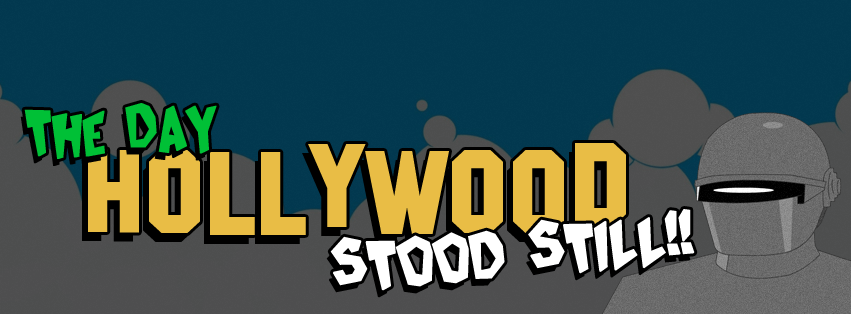Gort vs crap witches: 90-Year-Old Hookers
"It looks like a gothic version of the Adam West Batman - with a bit of the old ultraviolence"
 Dario Argento is perhaps one of cinema's greatest auteurs. His films are so deeply symbolic that you'll either find yourself marvelling at the ingenious subtext or else wondering at the beauty of the cinematography while convinced there's a meaning to it that's going far above your head. This may be because there isn't one, as Argento is a director who is prone to impulsive flights of fancy, but nonetheless, every moment seems sodden with import. Thankfully for us, the famous Italian maestro has dedicated himself to making exploitation horror movies.
Dario Argento is perhaps one of cinema's greatest auteurs. His films are so deeply symbolic that you'll either find yourself marvelling at the ingenious subtext or else wondering at the beauty of the cinematography while convinced there's a meaning to it that's going far above your head. This may be because there isn't one, as Argento is a director who is prone to impulsive flights of fancy, but nonetheless, every moment seems sodden with import. Thankfully for us, the famous Italian maestro has dedicated himself to making exploitation horror movies. While Argento's regular giallo territory is a genre with set rules and boundaries, it was in his Three Mothers trilogy that his unbridled imagination was set loose. Right from the outset, the first part, Suspiria opens with a bang. On a dark and stormy night, a spectacularly-eyebrowed girl arrives from America to study ballet at a prestigious dance school in Freiburg, Germany. She finds the school shut and a recently-expelled student running away in a panic. Ballet Rebel Girl runs into the forest and back to the town, where she stays the night with a friend. Staring out the window, she catches sight of a pair of disembodied eyes hanging before an arm so hairy it must belong to an Italian breaks through the window and smooshes her face up against it. After a few moments of pulling some spectacular faces, Ballet Rebel is dragged out the window and stabbed so many times the knife digs through to her still beating heart, before she has a phone cable wrapped around her and is flung through a skylight to have her neck broken as she is hung.
While Argento's regular giallo territory is a genre with set rules and boundaries, it was in his Three Mothers trilogy that his unbridled imagination was set loose. Right from the outset, the first part, Suspiria opens with a bang. On a dark and stormy night, a spectacularly-eyebrowed girl arrives from America to study ballet at a prestigious dance school in Freiburg, Germany. She finds the school shut and a recently-expelled student running away in a panic. Ballet Rebel Girl runs into the forest and back to the town, where she stays the night with a friend. Staring out the window, she catches sight of a pair of disembodied eyes hanging before an arm so hairy it must belong to an Italian breaks through the window and smooshes her face up against it. After a few moments of pulling some spectacular faces, Ballet Rebel is dragged out the window and stabbed so many times the knife digs through to her still beating heart, before she has a phone cable wrapped around her and is flung through a skylight to have her neck broken as she is hung. |
| Never before had inserting a tampon gone so wrong |
 This is rightly held as one of horror's scariest scenes, mainly because of the juxtaposition of intentionally-ghastly art deco and amped-up colours - like a gothic version of the Adam West Batman - with a bit of the old ultraviolence. This conflict comes from Argento's original intentions. Suspiria was written as a fairytale about a young girl discovering a witch living beneath her ballet school, but this was a hard sell for studios. Argento and partner Daria Nicolodi aged the cast into their 20s and crowbarred in some gore, but otherwise left the plot intact; even raising the door handles throughout the film to give the impression of youth to the cast and inserting a once-upon-a-time-style narration at the start.
This is rightly held as one of horror's scariest scenes, mainly because of the juxtaposition of intentionally-ghastly art deco and amped-up colours - like a gothic version of the Adam West Batman - with a bit of the old ultraviolence. This conflict comes from Argento's original intentions. Suspiria was written as a fairytale about a young girl discovering a witch living beneath her ballet school, but this was a hard sell for studios. Argento and partner Daria Nicolodi aged the cast into their 20s and crowbarred in some gore, but otherwise left the plot intact; even raising the door handles throughout the film to give the impression of youth to the cast and inserting a once-upon-a-time-style narration at the start.While there's a lot to admire about the direction of Suspiria, it's a lot easier to be impressed by than enjoy. It oscillates between absurd levels of violence and being completely chaste. The chaste moments are slow and the dialogue is intentionally impenetrable, while the violence is all downhill from that opening. Though the final reveal of the witch - reportedly played by an ex-hooker in her 90s that Argento found on the streets of Rome - is nicely creepy. Overall, the look of the film is among Argento's best work and it's rightly held as one of the few horror movies Italy produced in the 70s that can be studied in film school.
Check back at DayHWStoodStill tomorrow for our review of the second part of Argento's trilogy - Inferno.


